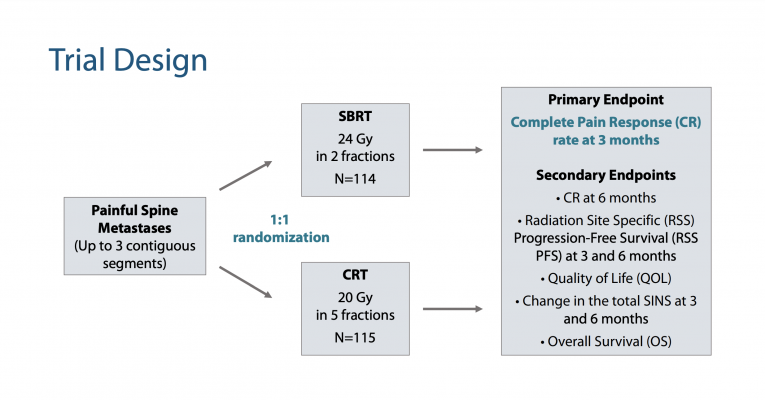
October 26, 2020 — A new study shows using fewer and higher doses of high-precision radiation therapy is a more effective approach for treating painful spinal tumors than conventional radiation therapy. More than twice as many patients treated with stereotactic body radiation therapy (SBRT) reported an enduring, complete reduction in pain, compared to those treated with conventional radiation. Findings from the Canadian phase II/III trial (NCT02512965) was presented today at the American Society for Radiation Oncology (ASTRO) Annual Meeting (ASTRO).
“This is the first phase III randomized trial that has shown an improvement with dose escalation for painful spinal lesions,” said lead author Arjun Sahgal, M.D., a professor and deputy chief of radiation oncology at the Sunnybrook Health Sciences Centre of the University of Toronto. “Pain deteriorates a patient’s quality of life and nobody with advanced cancer should have to endure this kind of pain. Patients with painful spinal metastases who meet the eligibility criteria should be offered this treatment.”
Spinal metastases are lesions on the spine that have spread from cancer that first occurred elsewhere in the body. While cancer can spread to any part of the body, two-thirds of patients with cancer will experience bone metastases, most commonly in the spine; in fact, research has shown that 70% of patients with terminal cancer develop spinal metastases before they die. Tumors that grow in the spine can cause pain, bone instability and neurologic symptoms, such as weakness, difficulty walking and bowel and bladder problems. Once cancer has spread to the spine, it is rarely considered curable, though there are treatment options to help patients live longer with less pain.
Radiation therapy is commonly used to relieve the pain of spinal metastases, by shrinking the tumors and reducing inflammatory cells. It is delivered through multiple fractions of lower-dose, conventional radiation (CRT), or though SBRT, which allows radiation oncologists to target tumors precisely with very high doses of radiation in fewer fractions. No definitive standard-of-care dose has yet been established for radiation therapy to treat painful spinal metastases.
In this phase II/III study from the Canadian Cancer Trials Group, researchers randomized patients whose primary tumors (mainly in the breast, urinary tract or lung) had metastasized to painful spinal lesions. Patients were treated with either two SBRT fractions for a total dose of 24Gy (n=114), or five CRT fractions for a total dose 20Gy (n=115). Eligible patients reported initial pain scores of greater than two on a scale of 1-10 (with a median score of five) using the Brief Pain Inventory. Pain scores were measured again at three and six months.
Patients in both treatment groups experienced reductions in pain from spinal metastases. After three months, 35% of patients in the SBRT arm of the trial, compared to 14% of those in the CRT arm, reported a complete response rate, or no remaining pain from their lesions (p<0.001). Patients continued pain free for up to six months, when the study concluded, with 32% of those in the SBRT arm reporting no pain compared to 16% of those in the CRT arm (p=0.004).
“This was not just, ‘Oh, I feel a little bit better,’” said Sahgal, adding that patients experienced the reduction in pain without increasing the use of pain medications. Multivariable analyses confirmed that the type of radiation was the independent factor driving pain response, not characteristics such as the patient's age, performance status or type of primary cancer. “We applied a very stringent trial design to focus on the impact of radiation,” said Sahgal. “It was the radiation treatment that led to the improvement.”
There was no difference between the study arms in radiation site-specific progression-free survival or overall survival. After three months, 92% of patients in the SBRT arm and 86% of those in the CRT arm were cancer-free at the treated site (p=0.4); the rates at six months were 75% and 69% (p=0.4).
In terms of adverse events, both treatments were safe with respect to fractures and there was no radiation damage to the spinal cord observed in either cohort. Overall, both arms had low rates of serious adverse events and there were no fatal events.
The study also found higher satisfaction from patients in the SBRT arm with quality-of-life measures related to financial considerations, although other quality of life measures did not differ between the two groups. “Patients felt they were in a financially better position coming to the hospital and getting two treatments, rather than five,” Sahgal said. “Even though the complexity of the treatment was greater, it was better for the patient.”
A different study reported at ASTRO’s 2019 Annual Meeting (RTOG 0631) found no difference in pain reduction between patients treated for spinal metastases with SBRT and those treated with conventional radiation. In Sahgal's study, however, patients were given a higher dose of radiation, an SBRT dose of 24Gy in two fractions, compared to the earlier trial's dose of 16/18Gy in a single fraction.
Sahgal said he was motivated to conduct this research out of frustration over the years with being unable to adequately relieve the suffering of patients with advanced stage cancer. “We saw we were getting improvements in pain, but our patients were not pain-free. With the development of SBRT, and spinal SBRT in particular, we started to wonder if we could do better. With these new research results, we think we can.”
For more information: www.astro.org


 December 11, 2025
December 11, 2025 









